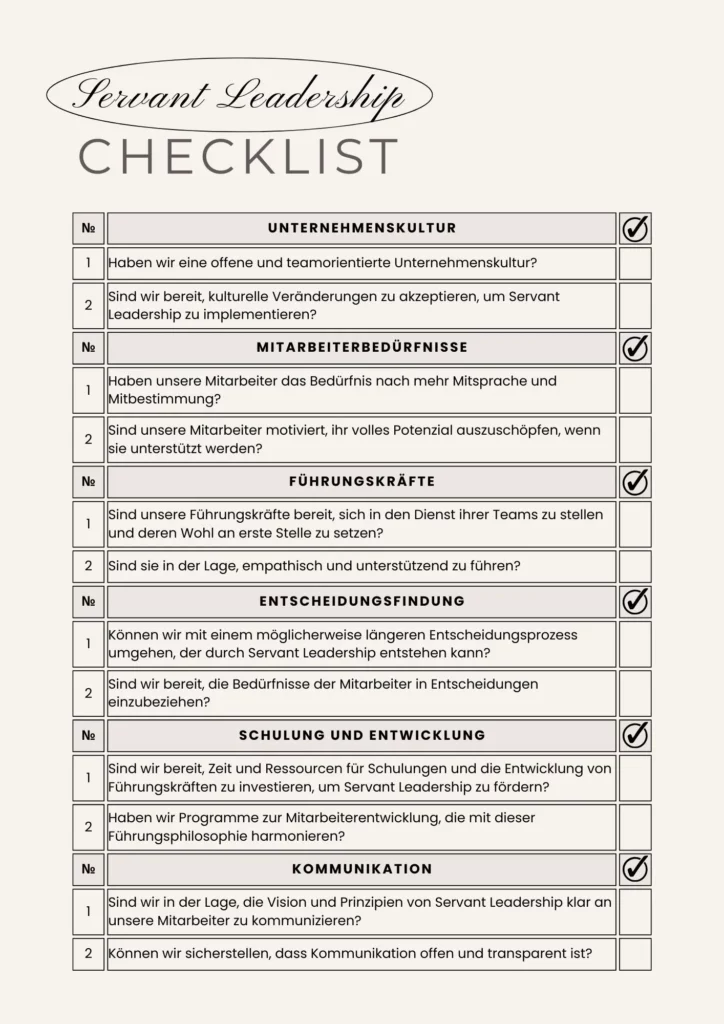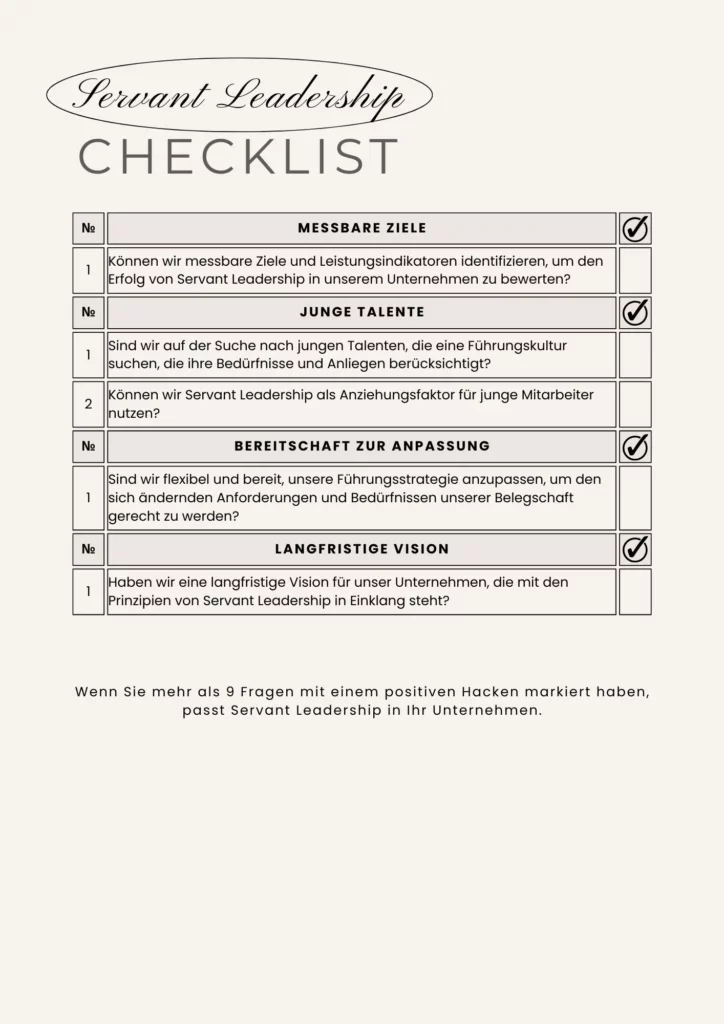Servant Leadership – the art of serving – turns traditional leadership models on their head. Servant Leadership – the art of serving – turns traditional leadership models on their head. Here, the boss is not only the top decision-maker, but also a helper, supporter and advocate for his employees.
Servant leadership is all about how leaders can promote the success of their teams by acting in an empathetic, appreciative and community-oriented way. But how does the concept of “leading” fit with that of “serving”? What specific tasks does a servant leader take on in practice? In this article we address all these questions and give you a first insight.
What is Servant Leadership? A definition
Servant leadership is like a breath of fresh air in the world of corporate leadership. The idea was founded by Robert Greenleaf and has become firmly established in leadership research. But what makes this philosophy so unique?
Imagine you are in an orchestra and your boss is not the conductor on the podium, but the violinist in the front row. Servant leadership turns the traditional leadership approach on its head. While traditional models focus on the well-being of the company, Servant Leader puts the employees in pole position. It’s as if the boss is saying, “Hey, how can I help you reach your full potential?
A Servant Leader shares power generously, puts the needs of their employees first and acts as coach, mentor and motivator all in one. Here, the boss is not the one who is served by his employees, but the one who serves them.
Principles of Servant Leadership

Servant Leadership is a set of clear principles that define this leadership philosophy. These principles are like building blocks on which the Servant Leadership building rests. Let’s take a closer look:
- listening: A servant leader is not a monologuing hero, but an active listener. He has an open ear for the concerns and ideas of his employees.
- empathy: Empathy is at the heart of servant leadership. A servant leader understands the feelings and needs of his team members and shows genuine empathy.
- healing: Conflict is inevitable, but a servant leader helps to heal it and create a harmonious work environment.
- awareness: A Servant Leader has a keen awareness of the needs of their staff and the community in which they work.
- Visionary thinking: Servant Leaders have a clear vision and the ability to communicate this vision convincingly.
- foresight: Servant leadership goes beyond the moment. A servant leader thinks ahead and plans for the future.
- persuasiveness: The ability to win others over to the vision is crucial. A servant leader can argue convincingly and inspire.
- conceptualisation: Putting ideas into practice requires clever conceptualisation. A servant leader can transform abstract concepts into concrete plans.
- stewardship: Servant leadership means taking responsibility for the well-being of the organisation and its members.
- Commitment to the growth of people and communities: Ultimately, a servant leader is not only interested in leading the organisation, but also in promoting the growth and development of their people and the community in which they operate.
These principles are a guide that lead a servant leader on their journey to becoming a servant leader.
Practical example: Mahatma Gandhi
Mahatma Gandhi, one of the best-known leaders of India’s independence movement, is an outstanding example of servant leadership. His entire life and work were shaped by the principles of servant leadership.
Gandhi spent a lot of time listening to the concerns, needs and aspirations of the Indian people, especially the poorer and oppressed people (listening). He showed sincere empathy for the suffering of the people under British colonial rule and actively campaigned for their rights (empathy).
Conflict is inevitable, but Gandhi always sought non-violent solutions and was an advocate of non-violent resistance to bring about change (healing). He had a deep awareness of the social and political problems of his time and worked to raise people’s awareness of these problems (consciousness).
Gandhi had a clear vision of an independent India characterised by non-violence and social justice, and he was able to communicate this vision convincingly (visionary thinking). His struggle for India’s independence was long-term and he focused on long-term change through the power of the non-violent movement (Foresight).
He was able to inspire millions of people to join his non-violent resistance and fight for India’s independence(power of persuasion). Gandhi developed clever strategies and tactics to put his vision into practice, including boycotts and the March to the Salt Lake(conceptualization).
He felt a high degree of responsibility for the well-being of his fellow human beings and resolutely stood up for their interests(sense of responsibility/stewardship). His commitment to India’s independence and the principles of non-violence and social justice contributed significantly to the growth and development of Indian society(commitment to the growth of people and communities).
Overall, Mahatma Gandhi is a living example of servant leadership as he dedicated his life to serving others and realizing a vision for a better society. His legacy continues to inspire people around the world to apply the principles of servant leadership in their own lives and work.
Classic leadership vs. servant leadership
Classic leadership and servant leadership differ in their approaches and focal points. Here are some differences:
Classic leadership:
- The focus is on achieving goals and results.
- The manager is the authority figure and makes decisions.
- Employees work to achieve the company’s goals.
- The manager gives instructions and monitors the work of the employees.
- Employees are assessed and rewarded or punished according to their performance.
Servant Leadership:
- The focus is on the development and well-being of employees.
- The manager actively listens and shows empathy for the needs of the employees.
- Employees work to achieve their own goals and are supported in this by their manager.
- The manager shares power and responsibility with the employees.
- Employees are encouraged to contribute ideas and solutions.
- The manager promotes the growth and development of employees.

The 3 most important advantages of servant leadership
Servant leadership is not only an innovative management philosophy, but also brings with it a wealth of benefits that are invaluable for both managers and employees. Here are the three most important benefits of servant leadership:
- Higher employee satisfaction: One of the most striking benefits of servant leadership is higher employee satisfaction. Under this management philosophy, employees feel supported and encouraged, which leads to a positive working atmosphere. When employees feel heard and valued, their satisfaction and commitment increase.
- Better performance: Servant leadership acts as a catalyst for employee performance. Through motivation and inspiration, they are encouraged to realize their full potential. This not only leads to individual growth, but also to improved performance of the team and the company as a whole.
- Attractive working environment for young employees: At a time when young talent is looking for meaningful work experiences, servant leadership is proving to be extremely attractive. This philosophy takes into account the needs and concerns of young employees who are looking for a management culture that promotes their potential and focuses on their growth. This makes Servant Leadership a desirable choice for companies looking to attract top talent.
These benefits make servant leadership an attractive management philosophy that can help to create a positive working environment in which employees can develop their full potential. When managers put themselves at the service of their teams and focus on their well-being, everyone involved benefits from fruitful collaboration.
The 3 biggest disadvantages of servant leadership
While servant leadership is undoubtedly an inspiring leadership philosophy, it also comes with some challenges and potential drawbacks that need to be considered. Here are the three biggest disadvantages of servant leadership:
- Not everyone is suitable: One possible disadvantage is that not every employee or manager is suitable for this type of leadership. Some employees may prefer a clearer structure and instructions to a manager who focuses strongly on their individual needs. In a heterogeneous workforce, it can be difficult to find a management strategy that is equally effective for everyone.
- Cultural change and training needs: The transition from a traditional management structure to servant leadership can be difficult. A profound cultural change in the organization and the training of managers are often required to successfully implement this type of leadership. Not all companies are willing or able to implement this change at their own pace.
- Decision-making and conflicts: Another potential disadvantage is that it can be difficult to make decisions. Servant leaders often try to consider the needs of all employees, which can slow down the decision-making process. This can clash with the needs of the company, which sometimes has to act quickly.
It is important to emphasize that these disadvantages do not necessarily mean that servant leadership is not an effective leadership strategy. Rather, they should be considered as aspects that should be taken into account when deciding whether servant leadership is suitable for a particular organization and for particular teams. Careful consideration of the pros and cons can help you make the most of this inspiring management philosophy and make the right decisions.
Checklist: Servant Leadership
Would you like to know whether the Servant Leadership management style suits your company? Then print out the following checklist and answer all the questions.
Conclusion
Servant leadership brings significant benefits such as increased employee satisfaction and better performance, but also some challenges. Ultimately, it’s about finding the right balance. This philosophy reminds us that successful leadership is based on empathy and the pursuit of individual growth. In an ever-changing world, servant leadership could be the key to preserving humanity in the workplace.
Books for managers and those who want to become one
You really do exist! Books that improve your leadership and delegation skills. In the course of my time as a founder and manager, I have read many books. Leadership books that helped me with my first steps and other books that helped me at an advanced stage. Here are my top 3 leadership books from which I still learn a lot today.













0 Comments